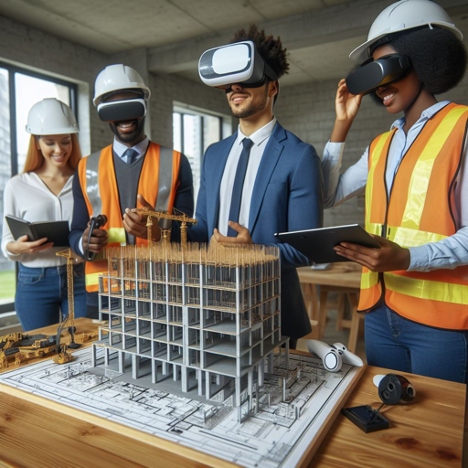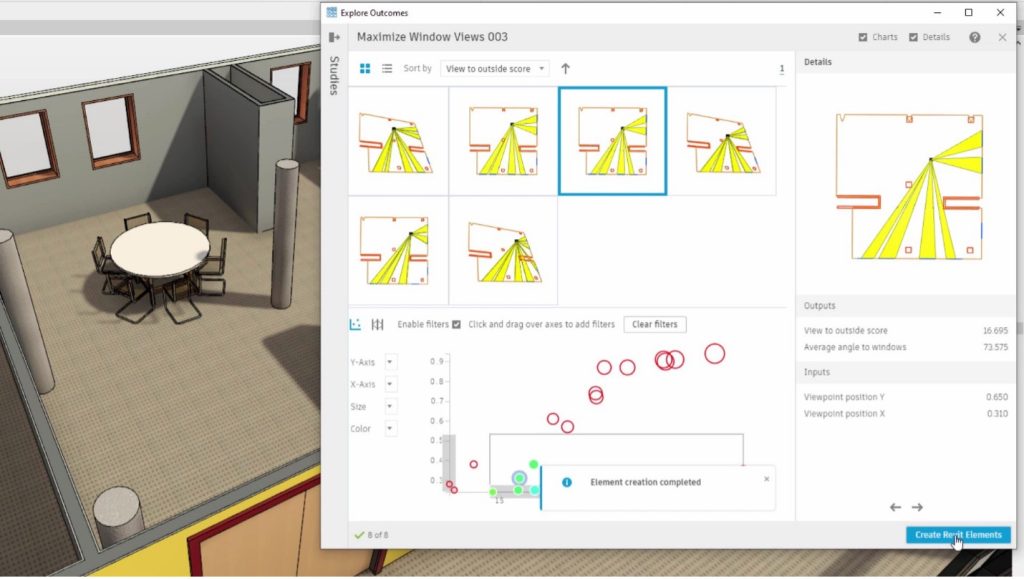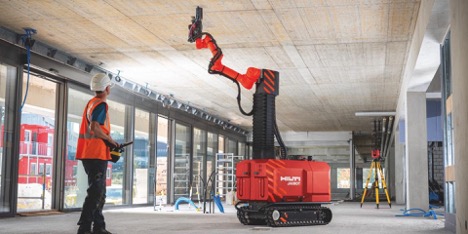
Emerging technologies such as Artificial Intelligence (AI), Virtual Reality (VR), Augmented Reality (AR) and Collaborative Robotics (cobots) are revolutionizing the industry, particularly in design-build projects. These technologies elevate collaboration, increase efficiency and enable more informed decision-making, which collectively reduce project risks and costs. By integrating these advancements, design-build construction projects can achieve faster completion times, better coordination, reduced costs and higher quality outcomes.
From design to safety, AI is making a difference in building projects.
Artificial intelligence (AI) is not only a buzzword in the tech world but also a game-changer in the construction industry. AI refers to the ability of machines to perform tasks that normally require human intelligence, such as planning, decision making and problem solving. By analyzing extensive data sets, AI algorithms enhance predictive modeling, cost estimation and risk assessment. They optimize construction schedules, identify potential issues and inform decision-making.

- There are several AI tools that can help construction companies improve efficiency, quality and safety in various aspects of their projects. Autodesk’s Generative Design tool uses AI to explore thousands of design options based on the project team’s goals and constraints. With this tool, architects and engineers can create better designs by analyzing data, generating alternatives and optimizing solutions. The software can create complex shapes and lightweight structures that may not be possible with traditional design methods. This opens doors for innovative and efficient designs that meet specific needs. By generating a multitude of design options, generative design can help identify potential problems early in the design process. This allows architects to address challenges like structural conflicts or inefficient use of space before significant time and resources are invested.
- ALICE Technologies AI analyzes project data and constraints to generate numerous feasible schedules. This allows users to compare options and identify the most efficient plan for completing the project on time and within budget. By simulating various project paths, ALICE helps identify potential bottlenecks and areas for improvement before construction begins. This allows users to develop more realistic and risk-mitigated schedules, leading to fewer delays.
- Oracle Newmetrix (formerly Smartvid.io) uses AI to analyze images and videos from construction sites to identify safety issues, such as workers not wearing helmets or gloves. AI can help improve safety on construction sites by detecting hazards, preventing accidents and alerting workers. Newmetrix analyzes various project data, including safety observations, manpower information and photos. Using AI models, it predicts which projects have the highest risk of experiencing safety incidents each week. Newmetrix also provides insights into why those projects are at risk.
Cobots can have a significant impact on construction.

Collaborative robotics –– or cobots –– are robots that can work alongside humans, enhancing their capabilities and productivity. Cobots can perform tasks that are repetitive, dangerous or require high precision, such as bricklaying, welding, painting and material handling. Cobots can also learn from human feedback and adapt to different scenarios and environments. They improve safety, reduce labor costs and accelerate project timelines.
- Hilti’s Jaibot, a semi-autonomous drilling robot, can execute overhead drilling plans faster and safer than humans.
- Built Robotics’ autonomous bulldozers, excavators and skid steers can operate 24/7 and follow digital blueprints with GPS and sensors.
- Dusty Robotics’ FieldPrinter can print layout plans on the floor of a construction site, reducing errors and saving time.
To be clear, it’s important to note that cobots are not intended to replace human workers. Instead, they are designed to work alongside them, augmenting their capabilities and improving overall project efficiency. Cobots can also help address the labor shortage and skills gap in the construction industry, as they can take over the most tedious and hazardous tasks, allowing workers to focus on more creative and complex aspects of the project.
VR and AR are emerging technologies that are transforming the construction industry.
VR and AR can create immersive and interactive simulations of the building environment, allowing practitioners and clients to collaborate and visualize the project in 3D throughout the project lifecycle. AR overlays digital elements onto the real world, enhancing a user’s surroundings by projecting images over what they see, while VR immerses the user in an entirely artificial environment, completely replacing the physical surroundings while wearing a headset.
VR enables stakeholders to explore 3D models at full scale, facilitating intuitive design reviews. AR overlays digital information onto the physical environment, aiding on-site workers in visualizing components and detecting clashes.
Listen to the May episode of the Design-Build Delivers Podcast to hear from Argyle CEO Maret Thatcher about AR in the AEC industry.
- Autodesk Workshop XR creates a collaborative design review workspace specifically for AEC teams. Accessible directly through Autodesk Construction Cloud, Workshop XR allows project stakeholders to enter a shared VR environment and examine 3D models in full scale. This fosters better communication and helps catch design flaws early which ultimately streamlines the construction process.
- Argyle is an AR application that seamlessly integrates BIM with real-world construction sites. It allows project managers, site workers and stakeholders to visualize BIM directly on site. Argyle’s features include contextual holomaps, metadata-rich holograms, anywhere alignment, entire model workflow, safety-first renderings and on-the-fly updates. The vision behind Argyle is to empower builders with sci-fi-like tools that work seamlessly in the real world. Argyle lets builders use features such as holograms that show data and fit the environment including 3D maps that match the context. Additionally, the platform shows the whole model workflow with accurate renderings through instant updates. The goal of Argyle is to give builders tools that seem like they come from sci-fi but work smoothly in the real world.
- IrisVR’s Prospect is a software that allows users to import their 3D models and explore them in VR using headsets like Meta Quest, Oculus Rift or HTC Vive. Users can also review and annotate the models, communicate with remote teammates and conduct safety training and inspections.
- Trimble’s Connect and FieldLink MR for HoloLens is a mixed reality solution that combines the 3D holographic capabilities of Microsoft HoloLens with the cloud-based collaboration platform of Trimble Connect. Users can overlay their 3D models onto the physical site and interact with them using gestures and voice commands.
From immersive design reviews to robotic fabrication, the future of design-build construction is increasingly intertwined with AI, VR, AR and collaborative robotics.

Troy Gates is Director of Innovation at USCAD. Gates brings more than 25 years of industry experience in his role as the Director of Innovation at U.S. CAD. Gates began his career in several CAD and engineering roles where he was responsible for CAD/BIM standards and training, Revit implementation strategies and client support. In many of his roles, he helped bridge the gap between design and IT, providing network infrastructure recommendations and collaborating with IT Managers on design technology-related projects. As a result, Gates often led his company’s design and BIM technology efforts, including creation and deployment of BIM standards and libraries, model collaboration and BIM execution plans. Previously, he led Design Technology teams at several AEC firms in Southern California. Additionally, Gates also develops add-ins for Revit and is well versed in Dynamo.
